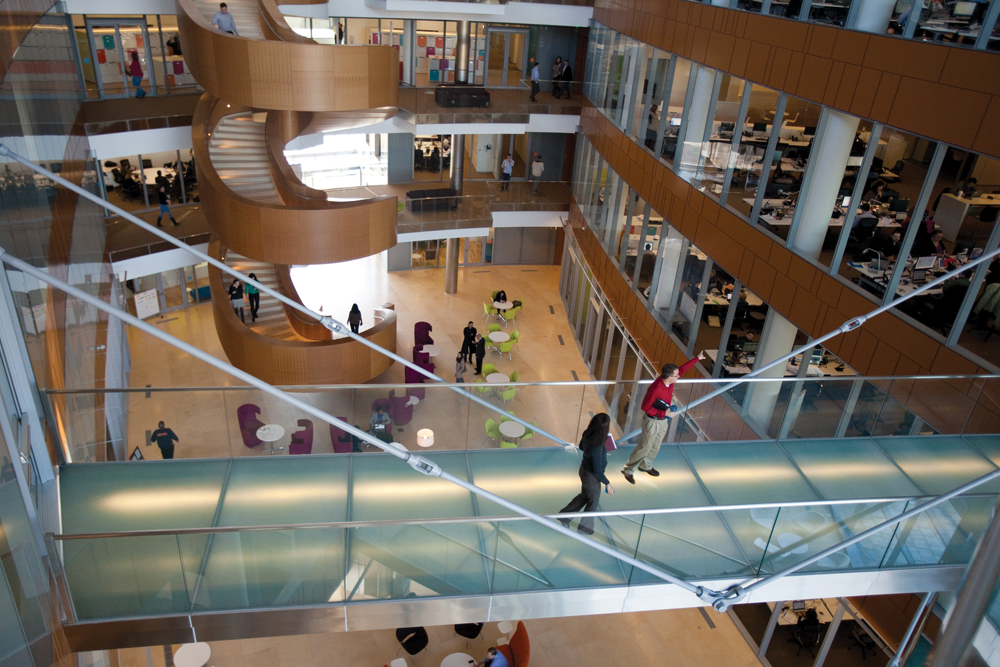Many firms that do office design and construction stayed afloat during the recession with modest projects—fit-outs, renovations, targeted green retrofits. But the sector’s finally heating up.
Commercial Realtors recently reported an increase in annual gross income for the third year in a row (www.BDCnetwork.com/Realtors2013). Jones Lang LaSalle’s latest office forecast pegged more than a dozen metros as being in “a rising phase,” including Austin, Dallas, Boston, Denver, Pittsburgh, Indianapolis, and New York (http://bit.ly/JLLOffice13).
Though speculative projects still lag, corporate HQs and medical office buildings are moving ahead. “The medical office building of the future can accommodate much of what was done in a traditional hospital setting,” says Steve Straus, President of Glumac. “Some of our clients have bold ambitions, including net-zero.”
TOP OFFICE SECTOR ARCHITECTURE FIRMS
2012 Office Revenue ($)1 Gensler $462,700,5002 HOK $128,726,0003 Perkins+Will $107,951,6724 NBBJ $64,002,0005 Stantec $62,500,2366 PageSoutherlandPage $43,190,0007 Heery International $39,443,9318 Kohn Pedersen Fox Associates $38,081,0009 RTKL Associates $37,474,00010 Hammel, Green and Abrahamson $37,307,000
TOP OFFICE SECTOR ENGINEERING FIRMS
2012 Office Revenue ($)1 AECOM Technology Corp. $830,320,0002 Parsons Brinckerhoff $146,400,0003 Jacobs Engineering Group $95,180,0004 Burns & McDonnell $82,020,0005 Thornton Tomasetti $50,861,4676 Michael Baker Jr. $50,720,0007 WSP USA $48,500,1628 Arup $32,355,6079 Buro Happold Consulting Engineers $28,720,00010 AKF Group $26,917,000
TOP OFFICE SECTOR CONSTRUCTION FIRMS
2012 Office Revenue ($)1 Turner Corporation, The $2,195,790,0002 Structure Tone $1,435,332,0003 PCL Construction Enterprises $1,409,212,7274 Clark Group $974,974,0665 Skanska USA $847,106,2426 Balfour Beatty $792,915,5767 Gilbane $690,915,0008 JE Dunn Construction $613,825,5639 James G Davis Construction $575,006,00010 HITT Contracting $535,524,009
On the West Coast, tech firms are creating eye-popping campuses, including NBBJ projects for Amazon (Seattle, 3.3 million sf); Samsung (San Jose, 1.1 million sf, with Arup); and Google (Mountain View, Calif., 1 million sf). Facebook tapped Frank Gehry to design its 420,000-sf Facebook West in Menlo Park, Calif., and Foster + Partners is designing Apple’s 2.8 million-sf, net-zero Campus 2 in Cupertino (to be built by DPR-Skanska.)
Bleeding-edge companies seek the latest in social engineering and sustainability, but they’re not alone in believing that generational and technological trends justify a reboot in office design. “The relevance of ‘the office’ is in question,” says Steve Hart, Director of Interior Design at Heery. “Why are you even in an office? We believe the office needs to help individuals feel connected to the company and support a common sense of purpose.”
Read BD+C's full Giants 300 Report
Related Stories
| Jan 25, 2011
Bloomberg launches NYC Urban Tech Innovation Center
To promote the development and commercialization of green building technologies in New York City, Mayor Michael R. Bloomberg has launched the NYC Urban Technology Innovation Center. This initiative will connect academic institutions conducting underlying research, companies creating the associated products, and building owners who will use those technologies.
| Jan 25, 2011
Top 10 rules of green project finance
Since the bottom fell out of the economy, finding investors and financial institutions willing to fund building projects—sustainable or otherwise—has been close to impossible. Real estate finance prognosticators, however, indicate that 2011 will be a year to buy back into the real estate market.
| Jan 25, 2011
Chicago invented the skyscraper; can it pioneer sustainable-energy strategies as well?
Chicago’s skyline has always been a source of pride. And while few new buildings are currently going up, building owners have developed a plan to capitalize on the latest advances: Smart-grid technologies that will convert the city’s iconic skyline into what backers call a “virtual green generator” by retrofitting high-rise buildings and the existing electrical grid to a new hyper-connected intelligent-communications backbone.
| Jan 25, 2011
AIA reports: Hotels, retail to lead U.S. construction recovery
U.S. nonresidential construction activity will decline this year but recover in 2012, led by hotel and retail sectors, according to a twice-yearly forecast by the American Institute of Architects. Overall nonresidential construction spending is expected to fall by 2% this year before rising by 5% in 2012, adjusted for inflation. The projected decline marks a deteriorating outlook compared to the prior survey in July 2010, when a 2011 recovery was expected.
| Jan 25, 2011
Jester Jones Schifer Architects, Ltd. Joins GPD Group
GPD Group is excited to announce that Jester Jones Schifer Architects, a Marion-based architectural firm, has joined our firm, now enabling GPD Group to provide architectural services to the Central-Ohio market.
| Jan 21, 2011
Combination credit union and USO center earns LEED Silver
After the Army announced plans to expand Fort Bliss, in Texas, by up to 30,000 troops, FirstLight Federal Credit Union contracted NewGround (as CM) to build a new 16,000-sf facility, allocating 6,000 sf for a USO center with an Internet café, gaming stations, and theater.
| Jan 21, 2011
Manufacturing plant transformed into LEED Platinum Clif Bar headquarters
Clif Bar & Co.’s new 115,000-sf headquarters in Emeryville, Calif., is one of the first buildings in the state to meet the 2008 California Building Energy Efficiency Standards. The structure has the largest smart solar array in North America, which will provide nearly all of its electrical energy needs.
| Jan 21, 2011
Primate research facility at Duke improves life for lemurs
Dozens of lemurs have new homes in two new facilities at the Duke Lemur Center in Raleigh, N.C. The Releasable Building connects to a 69-acre fenced forest for free-ranging lemurs, while the Semi-Releasable Building is for lemurs with limited-range privileges.
| Jan 21, 2011
Harlem facility combines social services with retail, office space
Harlem is one of the first neighborhoods in New York City to combine retail with assisted living. The six-story, 50,000-sf building provides assisted living for residents with disabilities and a nonprofit group offering services to minority groups, plus retail and office space.












